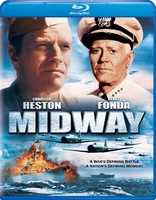Midway Blu-ray Movie
HomeMidway Blu-ray Movie 
Universal Studios | 1976 | 131 min | Rated PG | Jun 04, 2013Movie rating
7 | / 10 |
Blu-ray rating
| Users | 3.6 | |
| Reviewer | 3.5 | |
| Overall | 3.6 |
Overview
Midway (1976)
A dramatic chronicle of the Battle of Midway, considered the turning point of the war against Japan in the Pacific. Released in SENSURROUND
Starring: Charlton Heston, Henry Fonda, James Coburn, Glenn Ford, Hal HolbrookDirector: Jack Smight
| War | Uncertain |
| Drama | Uncertain |
Specifications
Video
Video codec: VC-1
Video resolution: 1080p
Aspect ratio: 2.35:1
Original aspect ratio: 2.39:1
Audio
English: DTS-HD Master Audio Mono .1 Sensurround
English: DTS 2.0
French: DTS 2.0
Subtitles
English SDH, French, Spanish
Discs
50GB Blu-ray Disc
Single disc (1 BD)
Playback
Region free
Review
Rating summary
| Movie | 3.5 | |
| Video | 4.0 | |
| Audio | 3.0 | |
| Extras | 4.0 | |
| Overall | 3.5 |
Midway Blu-ray Movie Review
Do you know how expensive war recreations are?
Reviewed by Brian Orndorf June 6, 2013Although positioned as a blockbuster release in 1976, “Midway” is more of a unique experiment in war film construction. While budget considerations obviously factored into the decision, famed producer Walter Mirisch decided to use archival footage and scenes from other movies to help generate the necessary expanse to this World War II effort, mixing the modern with the past, introducing the feature with the proclamation: “This is the way it was.” Well, technically, some of it wasn’t, but that doesn’t stop “Midway” from rolling forward as a movie primarily interested in naval stratagem, aiming for a balanced portrait of intelligence and instinct as the U.S. and Japan moved their animosity to the heart of the Pacific Ocean, treating the empty space as a chess board, embarking on a pivotal moment in WWII history. To hedge his bet, Mirisch hires an exceptional ensemble of famous faces who sink their teeth into the opportunity to play historical dress-up, keeping what’s actually a very deliberate picture alert with well-oiled thespian confidence.
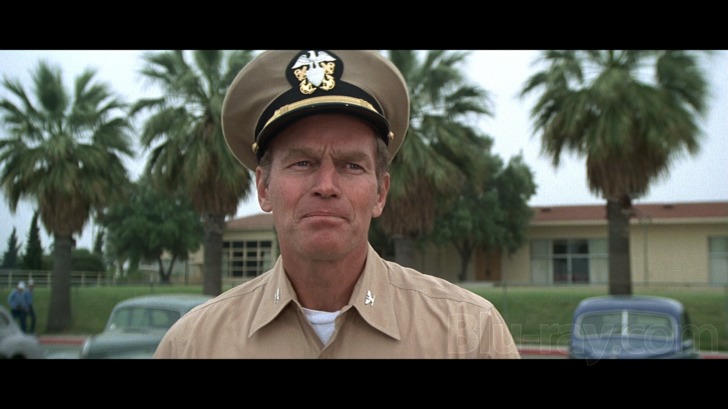
After the Japanese attack on Pearl Harbor, the U.S. military has worked diligently to gain the upper hand in WWII. Using his instincts and skill, cryptanalyst Commander Rochefort (Hal Holbrook) has discovered Japanese naval plans, persuading Captain Garth (Charlton Heston) to take a chance on the information, bringing it to the attention of Admiral Nimitz (Henry Fonda), a man keen to squash the enemy. Transmitting false information to lure the Japanese fleet into combat, American naval forces scramble into position, bringing in the likes of Rear Admiral Spruance (Glenn Ford) and Rear Admiral Fletcher (Robert Webber) to help lead the charge. On the other side of Pacific, the Japanese assemble a massive fleet to sink American ships, led by Admiral Yamamoto (Toshiro Mifune, who’s dubbed by Paul Frees), who puts his faith into subordinates such as Vice Admiral Nagumo (James Shigeta) to guide the armada to victory. As combat breaks out over the ocean, personal matters are also made a priority, finding Captain Garth’s son, Lieutenant Garth (Edward Albert), desperate to spring his Japanese-American girlfriend Haruko (Christina Kokubo) from an internment camp, needing his father’s influence to pull off such an impossible request.
Scripted by Donald S. Sanford, “Midway” has the posture of war cinema from the 1940s with its relentless discussions and earnest cast. The ‘70’s twist comes in the form of esteem for Japanese forces (and those who suffered inside interment camps), with nearly half of the effort dedicated to understanding Yamamoto’s motivation for the Midway run, observing his officers (including Pat Morita, John Fujioka, and Clyde Kusatsu) consider multiple ways to respond to recent bombings in Japan, engaging in hushed in-fighting to defeat the Americans six months after their victory at Pear Harbor. While the script favors U.S. forces, it doesn’t turn the Japanese military into a one-note antagonist, instead embracing the foe as a formidable opponent, aware of manipulations and respectful of triumphant strategy, creating a parallel depiction of intellect that’s remarkably civilized. Sandford is also mindful of jargon and Naval procedure, scripting a complex network of terms and acronyms that play directly to the WWII enthusiast aching for authenticity. The layperson will undoubtedly be thrown by the technical details of the picture, which are massaged for over an hour as the story builds to war.
“Midway” isn’t particularly hard to follow, but its concentration on the minutiae of naval procedure, rank, and enemy tracking methods takes some getting used to. Director Jack Smight appears to understand the potential impenetrability of the movie, repeatedly returning to maps to keep viewers clued in to ship movement and future attacks, while aircraft carriers, pilots, and scouting missions are all clearly labeled, easing the sophisticated network of personnel involved in the historic showdown. There’s also an all-star cast deployed to hold attention to the screen, displaying the likes of Heston, Fonda, Holbrook, Ford, Robert Wagner, James Coburn, Robert Mitchum, and Cliff Robertson as the meaty men of the Navy, forming an Irwin Allen-style safety net of marquee names to guarantee interest in the picture. And for those with sharper eyes, Tom Selleck, Dabney Coleman, and Erik Estrada also appear in tiny supporting parts. The acting is uniformly terrific, delivering the passion and military rigidity necessary to capture the tension of the moment, while Albert brings a softer side to the effort as one of the star-crossed lovers in a subplot that’s syrupy, but a necessary diversion from all the concentration on codes and maps.
The archival footage used for “Midway” is a bizarre choice, though it does manage to capture the authentic intensity of combat, even if it never quite stitches into the fabric of the film as neatly as Mirisch would like to think. Movie clips from productions such as “Tora! Tora! Tora!” (a kindred spirit to “Midway”) show more polish, but there’s never a moment where Smight’s work and stock footage merges into one cohesive picture, though it’s a bold cinematic experiment. Perhaps it’s motivated by budgetary concerns (I assume money set aside for war sequences was blown on scotch and cigarettes for the grizzled cast) and it certainly doesn’t fool the eye, but the grainy, colored, blown-up shots of real-life disasters means well enough, with the opening and closing of “Midway” paying respect to those who fought and died in service.
Midway Blu-ray Movie, Video Quality 
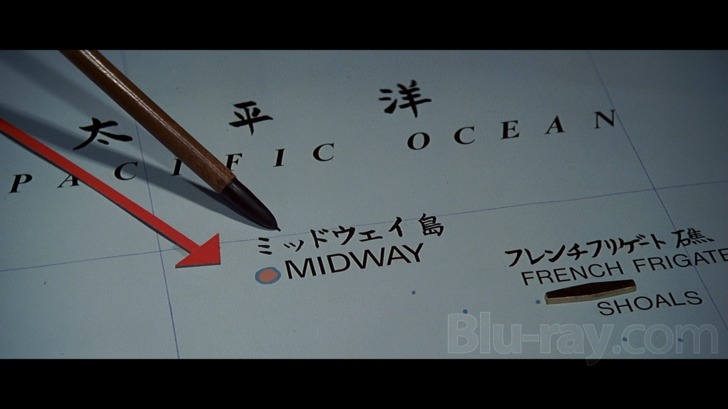
The VC-1 encoded image (2.35:1 aspect ratio) presentation on "Midway" is tricky to dissect, as much of the film employs actual footage from the front lines and other Hollywood productions. Although the raggedy quality is inherent to the source material, clarity on the BD makes the seams stand out. The stock footage is raw and dirty, blown-up and manipulated to match Smight's picture. The rest of the movie looks healthy and relatively undamaged, with slight sharpening to manage grain, though fine detail hasn't been erased -- useful to observe the pained expressions on the cast and enjoy the textures of the period recreation, including assorted military costuming. Shadow detail is occasionally murky, but rarely suffocating, displaying relatively stable, communicative blacks. Colors reveal some freshness with only a mild fade, finding oceanic excursions especially appealing with lighter blues, while uniforms display a secure range of interesting hues. Skintones are represented well, presenting leathery flesh as intended.
Midway Blu-ray Movie, Audio Quality 
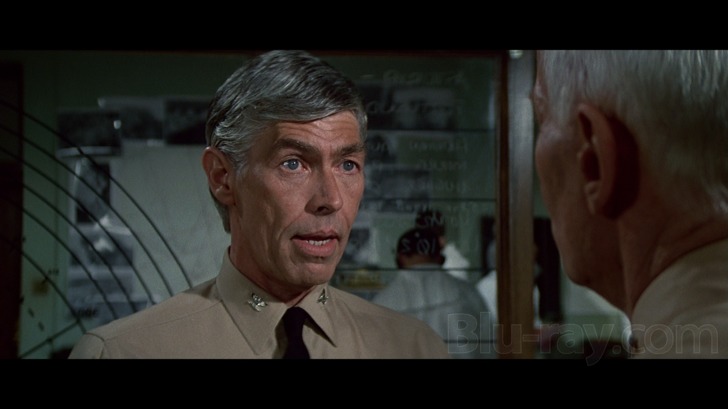
The 2.1 Sensurround mix is configured as a 5.1 DTS-HD track on the Blu-ray, though there's no surround activity that I could detect. It's a frontal force feature without a center channel, pushed into the left and right with a workable degree of clarity, isolating character interactions with crispness, while the considerable use of dubbing is expectedly artificial and easy to understand. Low-end is the big show here, and while there's a little more heft to roaring engines and bombings, it's not as spectacular as expected, requiring a little manual juicing to get the rumble where it should be. There's no distortion to the track, while scoring is blended satisfactorily, retaining it emphasis without stepping on human elements.
Midway Blu-ray Movie, Special Features and Extras 
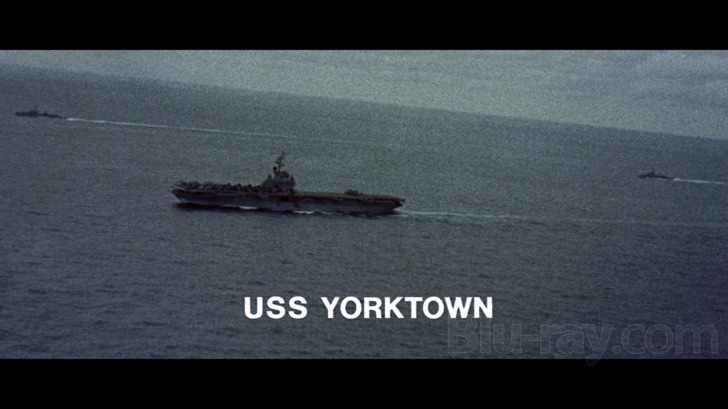
Ported over from the 2001 DVD release…
- "The Making of 'Midway'" (38:57, SD) is an impressively encompassing discussion of the film's creation, featuring an interview with producer Walter Mirisch to guide the featurette. Lead actor Charlton Heston, director Jack Smight, and additional key personnel are also included in the conversation, which covers the origin of the script, the assembly of the stock footage, the collection of A-list actors, and the technical challenges working with military might. It's a very professional, measured discussion of the effort, sharing several marvelous memories about the set, including actor Toshiro Mifune's remarkable professionalism and attention to character detail.
- "The Score of 'Midway'" (6:24, SD) sits down with legendary composer John Williams to dissect the motivation and emotional movements of the film music, and how the job fit into Williams's career at the time, having worked on several disaster movies prior to "Midway."
- "Sensurround: The Sounds of 'Midway'" (4:18, SD) inspects the special audio design employed to bring the picture to life during its initial theatrical release. Reflections from Heston (who also enjoyed the process for "Earthquake") and Smight are included.
- "Scenes Shot for the T.V. Version" (10:29, SD) present only a fraction of new footage created for the film's NBC premiere, intended to turn "Midway" into event television. The clips here center on a relationship between Captain Garth and girlfriend Ann (Susan Sullivan), who encourages the military man to embrace a more sensitive side to his personality. While deepening the emotional impact of the effort, the scenes resemble more of a 1970s television drama than a true addition to the war picture.
- "'They Were There,' Hosted by Charlton Heston" (6:20, SD) is a featurette from 1976 that celebrates military history and filmmaking authenticity, with Heston talking the viewer through the invention of the aircraft carrier and interviewing veterans of the Midway battle. And yes, the Heston neckerchief is here in full effect.
- Photograph Montage (2:58, SD) flips through promotional and production stills from the movie, accompanied by Williams's score.
- And a terrific Theatrical Trailer (2:57, SD) that emphasizes the "physical and emotional" impact of Sensurround is included.
Midway Blu-ray Movie, Overall Score and Recommendation 

"Midway" finally reaches a point of no return in the final act, unleashing a torrent of dogfights and heroic activity to capture the oddity of the conflict -- a naval battle that was largely decided in the air. There are few surprises here, yet the feature remains dependably engaging and charmingly acted, helping the production hurdle a few questionable artistic choices as it attempts to resurrect history over 30 years after the fact.
Similar titles
Similar titles you might also like

The Bridges at Toko-Ri
1954

Greyhound
2020

Run Silent, Run Deep
Special Edition
1958

The Gallant Hours
1960

The Caine Mutiny
1954

The Longest Day
1962

A Bridge Too Far
1977

Cross of Iron
1977

The Dirty Dozen
1967

Battle of the Bulge
1965

The Cruel Sea
1953

They Were Expendable
Warner Archive Collection
1945

In Harm's Way
1965

Stalingrad
1993

Eagles Over London
La Battaglia d'Inghilterra
1969

The Great Raid
Unrated Director's Cut
2005

The Bridge at Remagen
1969

Battle of Britain
1969

Sink the Bismarck!
1960

Wake Island
1942
